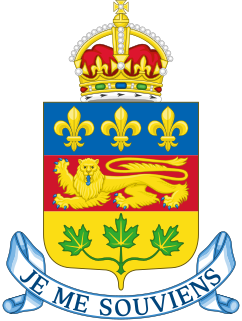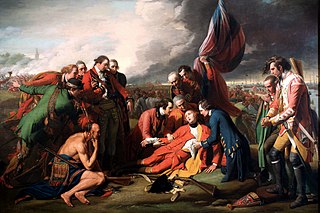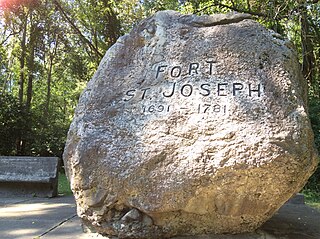
Nicolas Antoine Coulon, chevalier de Villiers was born in 1683, and died in 1733. He was an officer in New France.

Nicolas Antoine Coulon, chevalier de Villiers was born in 1683, and died in 1733. He was an officer in New France.
Born in Brittany and baptized March 20, 1683 in Nantes, [1] he was the son of Raoul-Guillaume Coulon, sieur de Villiers and Louise de Lafosse (m.1677, Beaumont-sur-Oise). Nicolas Antoine arrived in Quebec in 1703. In 1705, he married Angelique Jarret de Verchères (daughter of François Jarret de Verchères and Marie Perrot and sister Madeleine) in Quebec. At some time before 1718, Nicolas may have married Mme de La Chesaigne. [2]
In 1715, he became lieutenant in the French army. From 1725 to 1730, Nicolas was officer in command of Fort Saint Joseph. From this fort, he conducted in August 1730, a regiment of Canadiens and Amerindians against Fort Mesquakie of the Fox, constructed 60 leagues south of Lake Michigan, and joined the forces of Canadians at Fort Chartres and Fort Miami to prepare for the extermination of this tribe. In January 1731, the survivors of this campaign went to Nicolas Antoine at Fort Saint-Joseph, and later in the year, they accompanied them to Montreal, where Governor Marquis de Beauharnois forgave them. (The writings of de Montigny at Michilimackinac). From 1731 until his death - he was killed by a Sauk in September 1733 - he commanded and rebuilt the fort at La Baye in the Wisconsin. [3]
He had 7 sons of whom 4 followed in his footsteps. He also had 6 daughters.

Antoine de la Mothe, sieur de Cadillac, born Antoine Laumet, was a French explorer and adventurer in New France, which stretched from Eastern Canada to Louisiana on the Gulf of Mexico. He rose from a modest beginning in Acadia in 1683 as an explorer, trapper, and a trader of alcohol and furs, achieving various positions of political importance in the colony. He was the commander of Fort de Buade in St. Ignace, Michigan, in 1694. In 1701, he founded Fort Pontchartrain du Détroit ; he was commandant of the fort until 1710. Between 1710 and 1716, he was the governor of Louisiana, although he did not arrive in that territory until 1713.

This section of the Timeline of Quebec history concerns the events relating to the Quebec portion of New France between the establishment of the Sovereign Council and the fall of Quebec.

Events from the year 1747 in Canada.

Fort Saint Joseph was a fort established on land granted to the Jesuits by King Louis XIV; it was located on what is now the south side of the present-day town of Niles, Michigan. Père Claude-Jean Allouez established the Mission de Saint-Joseph in the 1680s. Allouez ministered to the local Native Americans, who were primarily Odawa and Ojibwe.

Verchères is an off-island suburb of Montreal, in Montérégie, Quebec, located on the south bank of the Saint Lawrence River. The population as of the Canada 2011 Census was 5,692.

The Battle of Fort Necessity, also known as the Battle of the Great Meadows, took place on July 3, 1754, in what is now Farmington in Fayette County, Pennsylvania. The engagement, along with the May 28 skirmish known as the Battle of Jumonville Glen, was George Washington's first military experience. The Battle of Fort Necessity began the French and Indian War, which later spiraled into the global conflict known as the Seven Years' War. Washington built Fort Necessity on an alpine meadow west of the summit of a pass through the Laurel Highlands of the Allegheny Mountains. Another pass nearby leads to Confluence, Pennsylvania; to the west, Nemacolin's Trail begins its descent to Uniontown, Pennsylvania, and other parts of Fayette County along the relatively low altitudes of the Allegheny Plateau.

Louis Coulon, Sieur de Villiers was a French military officer who served during the French and Indian War. Perhaps his greatest claim to fame is the fact that he is the only military opponent to force George Washington to surrender. Coulon was born into a prominent French Canadian family. His grandfather, Sieur Raoul-Guillaume Coulon, was an officer in the French Royal Army. He was the son of Nicolas Antoine Coulon de Villiers and Elizabeth Le Couturier. Louis Coulon de Villiers entered the military in 1733. He had risen to the rank of captain by the outbreak of the French and Indian War and was assigned to Fort Duquesne.
Joseph Coulon de Villiers, Sieur de Jumonville was a French Canadian military officer. His defeat and killing at the Battle of Jumonville Glen by forces led by George Washington was one of the sparks that ignited the Seven Years' War, known as the French and Indian War on the North American front.

The Battle of Jumonville Glen, also known as the Jumonville affair, was the opening battle of the French and Indian War, fought on May 28, 1754, near present-day Hopwood and Uniontown in Fayette County, Pennsylvania. A company of provincial troops from Virginia under the command of Lieutenant Colonel George Washington, and a small number of Mingo warriors led by the chieftain Tanacharison, ambushed a force of 35 Canadiens under the command of Joseph Coulon de Jumonville.

Marie-Madeleine Jarret, known as Madeleine de Verchères was a woman of New France credited with repelling a raid on Fort Verchères when she was 14 years old.
François-Marie Picoté, sieur de Belestre II was a colonial soldier for both New France and Great Britain.

François Coulon de Villiers was a French military officer from an influential military family in the French and Indian War and then an influential officer in the New Spain community of New Orleans.

The military of New France consisted of a mix of regular soldiers from the French Army and French Navy supported by small local volunteer militia units. Most early troops were sent from France, but localization after the growth of the colony meant that, by the 1690s, many were volunteers from the settlers of New France, and by the 1750s most troops were descendants of the original French inhabitants. Additionally, many of the early troops and officers who were born in France remained in the colony after their service ended, contributing to generational service and a military elite. The French built a series of forts from Newfoundland to Louisiana and others captured from the British during the 1600s to the late 1700s. Some were a mix of military posts and trading forts.
René Godefroy, Sieur de Linctot de Tonnancour was an early Canadien settler. He was from an early, prominent, French Canadian family.
Fort La Baye was a French military post at La Baye, originally built in 1684, remodeled in 1717, and occupied until 1760.
Louis Groston de Saint-Ange de Bellerive (1700–1774), was an officer in the French marine troops in New France.
Pierre Jarret de Verchères was a French Canadian military officer. His father, François, was the founder of Vercheres, a suburb of Montreal, Quebec. In 1691, as a teenager, along with his older sister Madeleine and his younger brother Alexandre, he helped defend his father's fort for a week. Jarret de Verchères was killed in 1708 after his raiding party was ambushed following an attack on Haverhill, Massachusetts.
Nicolas Antoine II Coulon de Villiers was a French military officer from an influential military family in the King George's War.
Events from the year 1754 in France.
Claude Marin de la Perrière was a Canadian fur trader.